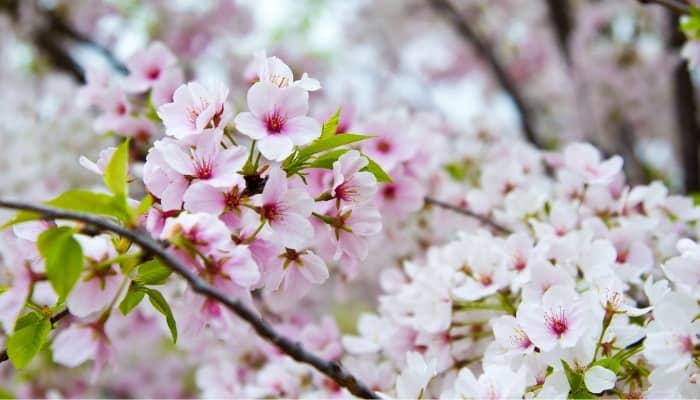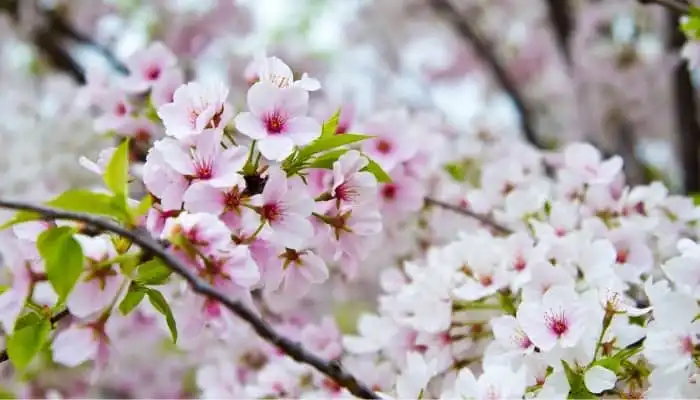During each spring, cherry blossom trees produce stunning blooms that emit a memorable fragrance. However, the concern is whether they thrive as indoor trees.
Can you grow a cherry blossom tree indoors? Cherry blossom trees are great choices for indoors. They are easy to maintain in comparison to many indoor plants and have beautiful flowers every spring. That said, even healthy cherry blossom trees benefit from a bit of time outdoors, especially in the summer and early fall.
Read on below and explore the full answers to everything you need to know about caring for indoor cherry blossom trees!
How To Grow a Cherry Blossom Tree Indoors
There’s a bit more to growing a cherry blossom tree indoors than growing a small houseplant, but it’s not exactly a hard or lengthy process.
In the following sections, we break down exactly what you need to do to successfully grow your own cherry blossom tree indoors, step-by-step.
Step 1. Selecting Your Cherry Blossom Tree
Depending on your idea of the perfect cherry blossom tree for your home, you should pick a tree according to its size.
Look for signs of stress, disease, or pests before choosing. Don’t forget to look for broken branches or damaged roots.
The next thing to consider when selecting your tree is whether or not it’s self-pollinating.
If you opt for one that isn’t, you’ll need to make sure it’s pollinated manually or taken outside near other cherry trees when blooming.
Cherry blossom trees need to chill at temperatures of 32°F to 45°F degrees during dormancy. Their chilling hour requirements vary from as little as 200 or 300 hours to as much as 1,000+ hours.
Best Cherry Tree Varieties for Growing Indoors
There are well over 200 types of cherry trees that grow indoors well. The following list contains the top 12:
- Pink Shell
- Yoshino
- Pink Perfection
- Shogetsu
- Hokusai
- Takasago
- Tai-haku
- Horinji
- Shosar
- Shirota
- Weeping
- Dwarf Weeping
Again, there are countless dozens of cherry blossom species that work great as indoor trees, and there are endless hybrids to choose from as well.
Step 2. Potting a Cherry Blossom Tree
The best potting mix for an indoor cherry blossom consists of sand, clay, and loam-based growing mediums.
The most important point is that it stays moist for extended periods of time but drains quickly and thoroughly.
Potting a cherry blossom tree is quick and easy once your soil is mixed:
- Add a few inches of pebbles or LECA to the bottom of the pot, and cover it with a few handfuls of soil.
- Place the tree’s root ball into the base of the pot, and unravel its roots to stretch them out.
- Add layers of dirt gently but firmly over the roots as you continue to fill the pot.
- Fill the top 3 to 4 inches of the pot with organic compost, mulch, or even woodchips.
- Water the tree thoroughly until you see water running out the bottom of the pot.
Now you’re ready to place your tree in the best location for it to begin transitioning to its new environment. Make sure it gets plenty of light and airflow.
Step 3. Watering and Fertilizing an Indoor Cherry Tree
Cherry blossom trees require a thorough watering every 24 to 48 hours the first week or two after planting indoors. Reduce watering to twice weekly for an additional few weeks, watering deeply each time.
Eventually, your indoor cherry blossom tree will only need to be watered once every 10 to 15 days.
Step 4. Replicating Natural Conditions
The most important step in replicating natural conditions for your cherry blossom tree is making sure that it gets between 8 and 10 hours of light per day.
Preferably at least 6 hours of that should be direct sunlight.
As mentioned above, indoor cherry trees require watering roughly every day or two when they are first planted, and their soil should be sandy/loamy and fast draining.
Additionally, giving them a small sip of water daily helps mimic morning dew and light rain.
To replicate natural winter dormancy, move the tree to an unheated garage or similar space in late fall or lower the temperature of the room in which the tree lives.
Step 5. Pruning Cherry Trees To Keep Them Small
The more often you prune your cherry tree, the smaller you can keep it in the long run (or, at least, the easier it becomes to keep it small).
The first year you plant your cherry tree, you need to remove several side branches.
In the second year, additional side branches will need trimming, as well as new shoots below the lowest branches.
In the third year and the following ones, remove as much as two-thirds of the top of the tree’s tallest branches and shoots.
When you repot your cherry tree (which we discuss in the next section), make sure to trim excess roots that are unnecessarily long.
This also helps keep reaffirm to the tree what size it should maintain.
Step 6. Repotting an Indoor Cherry Tree
Indoor cherry trees need repotting as much as every other year. That said, the older that they get, the less repotting is required.
For example, a 5- or 10-year-old indoor cherry tree needs repotting just once every 4 to 5 years (if that).
Repotting is easy: flip your tree upside down, and tap its container slightly. It’ll pop right out.
Set the tree in the sink or a bucket to soak for several minutes in fresh water. While the tree is soaking, clean its pot and refill it with fresh soil or prepare the new pot you want to put it in.
Follow the instructions from Step 2 above to get your cherry tree repotted.
Growing Cherry Trees in Pots – Considerations & Tips
Now that you know the basics, let’s take a quick dive into other considerations as well as tips from the pros about growing cherry trees in pots!
Chilling Hours for Cherry Trees
The average necessary chilling hours for cherry trees is approximately 600 to 800 hours.
That said, cherry trees have chilling hour requirements that range from 200 or 300 to as high as 1200. It all depends on the variety.
That means they require as little as a few weeks at chilling temperatures to as much as a couple of months before they will produce fruit.
Sweet vs. Sour Cherry Trees
If you are growing your indoor cherry tree for fruits, keep in mind the differences between sweet and sour cherries.
The size of sour cherries is typically a bit smaller, and they are obviously less sweet.
So, if you’re not planning to eat any cherries and want a nice small blossoming cherry tree, sour varieties are super popular.
Mature Size
Indoor cherry trees will grow as tall as you let them. In a home with cathedral ceilings and skylights, a cherry blossom tree could reach heights of 20 feet tall easily.
However, cherry blossom trees that are trimmed frequently and maintained for the purpose of keeping them small, do just that, reaching heights of anywhere from 18 inches to 8 feet tall.
Dwarf varieties and standard cherry trees have little differences when grown as indoor plants because indoor trees don’t often grow more than 8 feet or so, which is around the max height of dwarfs anyhow (though they technically can grow up to 15 feet or so).
Pollination
One aspect of cherry blossom trees that scares first-time tree parents is that they need to be pollinated by hand in order to produce fruit.
That said, it’s not really that big of a deal once you learn how to do it.
Here’s how:
- Collect pollen from another cherry tree variety.
- Using a paintbrush or cotton, dip into the pollen.
- Apply the pollen to as many of your tree’s flowers/buds as possible.
Keep in mind that you should try to pollinate your cherry tree’s flowers within half a day to 3 days of them initially opening up.
Related Questions:
Can You Grow a Cherry Tree From a Pit?
In many cases you can grow a cherry tree straight from the pit of cherries you purchased in the grocery store, but in some cases, they aren’t able to grow.
Even in the cases that they do grow, they may not be suited for your local climate. That’s why you should do research on what sort of cherry tree pit it is before planting it!
Why Is My Cherry Tree Not Flowering?
There are quite a few reasons that explain why your cherry tree is not flowering.
It may not have enough nutrients, the weather may have been fluctuating too much and confused its bloom instincts, birds or pests may have damaged it, or you may have over pruned it.
Conclusion
Growing an indoor cherry blossom tree is a fun and rewarding experience, hopefully this full care guide brings you nothing but success, from day one, with your new tree!


